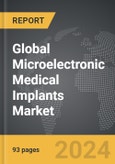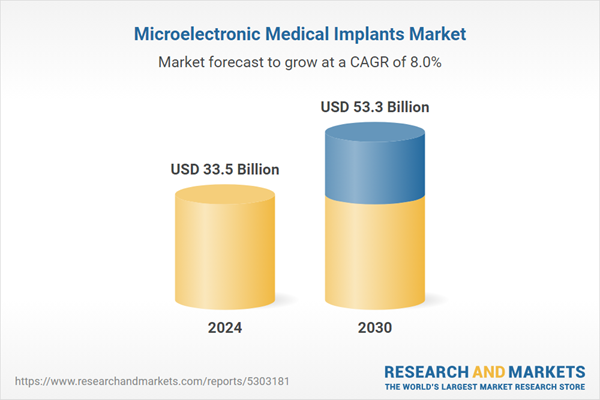The global market for Microelectronic Medical Implants was valued at US$33.5 Billion in 2024 and is projected to reach US$53.3 Billion by 2030, growing at a CAGR of 8.0% from 2024 to 2030. This comprehensive report provides an in-depth analysis of market trends, drivers, and forecasts, helping you make informed business decisions. The report includes the most recent global tariff developments and how they impact the Microelectronic Medical Implants market.
Segments: Product (Pacemakers & Defibrillators, Neurostimulators, Implantable Drug Pumps, Spinal Fusion Stimulators, Other Products); Technology (RF Technology, Sensors, Other Technologies).
Geographic Regions/Countries: World; United States; Canada; Japan; China; Europe (France; Germany; Italy; United Kingdom; and Rest of Europe); Asia-Pacific; Rest of World.
The analysts continuously track trade developments worldwide, drawing insights from leading global economists and over 200 industry and policy institutions, including think tanks, trade organizations, and national economic advisory bodies. This intelligence is integrated into forecasting models to provide timely, data-driven analysis of emerging risks and opportunities.
Global Microelectronic Medical Implants Market - Key Trends and Drivers Summarized
How Are Microelectronic Medical Implants Transforming Healthcare?
Microelectronic medical implants are miniature electronic devices implanted in the human body to diagnose, monitor, or treat medical conditions. These implants play a crucial role in managing chronic diseases, enhancing quality of life, and enabling personalized medical treatments. Some common applications of microelectronic medical implants include pacemakers, cochlear implants, neurostimulators, and insulin pumps. Their small size and ability to interact directly with the body's physiological systems make them a vital tool in modern healthcare. These implants are particularly significant in treating cardiovascular diseases, neurological disorders, and hearing impairments. For instance, pacemakers help regulate heart rhythms, while cochlear implants enable hearing in individuals with severe hearing loss. As the demand for minimally invasive treatments grows, microelectronic medical implants are becoming an integral part of healthcare, offering patients better therapeutic outcomes with fewer complications.What Innovations Are Shaping the Microelectronic Medical Implants Market?
The microelectronic medical implants market is being transformed by innovations in wireless communication, biocompatible materials, and battery technology. The development of wireless implants that can be controlled or monitored remotely through smartphones and other devices has revolutionized patient care, enabling real-time data transmission and remote monitoring by healthcare professionals. This has improved patient outcomes by allowing timely interventions and reducing hospital visits. Advances in materials science have also enabled the use of biocompatible and bioresorbable materials that minimize the risk of rejection by the body and reduce the need for surgical removal. Additionally, innovations in battery technology, such as the development of energy-harvesting devices that draw power from the body’s natural movements, are extending the lifespan of implants and reducing the need for frequent battery replacements.How Do Market Segments Define the Growth of Microelectronic Medical Implants?
Product types include pacemakers, neurostimulators, cochlear implants, and implantable drug pumps. Among these, pacemakers hold a significant market share due to the increasing prevalence of cardiovascular diseases. Neurostimulators, used in the treatment of conditions such as Parkinson's disease and chronic pain, are also experiencing rapid growth. In terms of application, the cardiovascular segment dominates the market, followed by neurology and hearing impairment. Regionally, North America and Europe lead the market due to advanced healthcare infrastructure, higher healthcare spending, and the presence of key medical device manufacturers. However, the Asia-Pacific region is expected to witness substantial growth due to increasing healthcare investments and a rising patient population.What Factors Are Driving the Growth in the Microelectronic Medical Implants Market?
The growth in the microelectronic medical implants market is driven by several factors, including the rising prevalence of chronic diseases, advancements in wireless communication technology, and increasing demand for minimally invasive treatments. As populations age and chronic conditions like cardiovascular diseases and neurological disorders become more common, the demand for medical implants is expected to rise. Furthermore, innovations in biocompatible materials and energy-efficient batteries are improving the performance and lifespan of implants, making them more appealing to healthcare providers and patients alike. The integration of wireless monitoring capabilities is also driving growth by enabling better patient management and reducing the need for invasive procedures.Report Scope
The report analyzes the Microelectronic Medical Implants market, presented in terms of units. The analysis covers the key segments and geographic regions outlined below.Segments: Product (Pacemakers & Defibrillators, Neurostimulators, Implantable Drug Pumps, Spinal Fusion Stimulators, Other Products); Technology (RF Technology, Sensors, Other Technologies).
Geographic Regions/Countries: World; United States; Canada; Japan; China; Europe (France; Germany; Italy; United Kingdom; and Rest of Europe); Asia-Pacific; Rest of World.
Key Insights:
- Market Growth: Understand the significant growth trajectory of the Pacemakers & Defibrillators segment, which is expected to reach US$22.7 Billion by 2030 with a CAGR of a 8.5%. The Neurostimulators segment is also set to grow at 9.0% CAGR over the analysis period.
- Regional Analysis: Gain insights into the U.S. market, valued at $8.9 Billion in 2024, and China, forecasted to grow at an impressive 7.8% CAGR to reach $8.5 Billion by 2030. Discover growth trends in other key regions, including Japan, Canada, Germany, and the Asia-Pacific.
Why You Should Buy This Report:
- Detailed Market Analysis: Access a thorough analysis of the Global Microelectronic Medical Implants Market, covering all major geographic regions and market segments.
- Competitive Insights: Get an overview of the competitive landscape, including the market presence of major players across different geographies.
- Future Trends and Drivers: Understand the key trends and drivers shaping the future of the Global Microelectronic Medical Implants Market.
- Actionable Insights: Benefit from actionable insights that can help you identify new revenue opportunities and make strategic business decisions.
Key Questions Answered:
- How is the Global Microelectronic Medical Implants Market expected to evolve by 2030?
- What are the main drivers and restraints affecting the market?
- Which market segments will grow the most over the forecast period?
- How will market shares for different regions and segments change by 2030?
- Who are the leading players in the market, and what are their prospects?
Report Features:
- Comprehensive Market Data: Independent analysis of annual sales and market forecasts in US$ Million from 2024 to 2030.
- In-Depth Regional Analysis: Detailed insights into key markets, including the U.S., China, Japan, Canada, Europe, Asia-Pacific, Latin America, Middle East, and Africa.
- Company Profiles: Coverage of players such as Abbott Laboratories, Abiomed, Inc., Biotronik, Boston Scientific Corporation, Cochlear Ltd. and more.
- Complimentary Updates: Receive free report updates for one year to keep you informed of the latest market developments.
Some of the 42 companies featured in this Microelectronic Medical Implants market report include:
- Abbott Laboratories
- Abiomed, Inc.
- Biotronik
- Boston Scientific Corporation
- Cochlear Ltd.
- Koninklijke Philips N.V.
- LivaNova PLC
- Medtronic plc
- Retina Implant AG
- Schiller
- Sound Tec, Inc.
- St. Jude Medical, Inc.
- Zimmer Biomet Holdings, Inc.
- Zoll Medical
Tariff Impact Analysis: Key Insights for 2025
Global tariff negotiations across 180+ countries are reshaping supply chains, costs, and competitiveness. This report reflects the latest developments as of April 2025 and incorporates forward-looking insights into the market outlook.The analysts continuously track trade developments worldwide, drawing insights from leading global economists and over 200 industry and policy institutions, including think tanks, trade organizations, and national economic advisory bodies. This intelligence is integrated into forecasting models to provide timely, data-driven analysis of emerging risks and opportunities.
What’s Included in This Edition:
- Tariff-adjusted market forecasts by region and segment
- Analysis of cost and supply chain implications by sourcing and trade exposure
- Strategic insights into geographic shifts
Buyers receive a free July 2025 update with:
- Finalized tariff impacts and new trade agreement effects
- Updated projections reflecting global sourcing and cost shifts
- Expanded country-specific coverage across the industry
Table of Contents
I. METHODOLOGYII. EXECUTIVE SUMMARY2. FOCUS ON SELECT PLAYERSIII. MARKET ANALYSISIV. COMPETITION
1. MARKET OVERVIEW
3. MARKET TRENDS & DRIVERS
4. GLOBAL MARKET PERSPECTIVE
UNITED STATES
CANADA
JAPAN
CHINA
EUROPE
FRANCE
GERMANY
ITALY
UNITED KINGDOM
REST OF EUROPE
ASIA-PACIFIC
REST OF WORLD
Companies Mentioned (Partial List)
A selection of companies mentioned in this report includes, but is not limited to:
- Abbott Laboratories
- Abiomed, Inc.
- Biotronik
- Boston Scientific Corporation
- Cochlear Ltd.
- Koninklijke Philips N.V.
- LivaNova PLC
- Medtronic plc
- Retina Implant AG
- Schiller
- Sound Tec, Inc.
- St. Jude Medical, Inc.
- Zimmer Biomet Holdings, Inc.
- Zoll Medical
Table Information
| Report Attribute | Details |
|---|---|
| No. of Pages | 93 |
| Published | April 2025 |
| Forecast Period | 2024 - 2030 |
| Estimated Market Value ( USD | $ 33.5 Billion |
| Forecasted Market Value ( USD | $ 53.3 Billion |
| Compound Annual Growth Rate | 8.0% |
| Regions Covered | Global |









